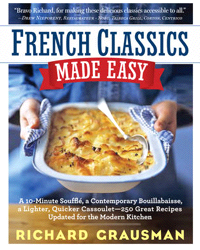Richard Grausman is a busy man. He run Careers through Culinary Arts Program (C-Cap), the nonprofit that works with public schools across the country to prepare underserved high school students for college and career opportunities in the restaurant and hospitality industry. Luckily, he still has time to write French Classics Made Easy (Workman 2011). Making French cooking accessible to American cooks is a life-long passion. His first cookbook, At Home with the French Classics (Workman 1988) tried to do the same thing:
Above all, my primary objective has been foolproof recipes that remain unmistakably French even though their proportions and preparations may have changed. It is my hope that this book will bring understanding and enjoyment to all who read it, and give pleasure to all who feast from it. (p. 2)
This book is a capable update of the last book – going further to update recipes so that Americans can easily cook and enjoy them. If you are intimidated or baffled by Julia Child‘s lengthy recipes – French Classics Made Easy is a welcome rethinking (and shortening) of those classics.
 Take Blanquette de Veau Aux Morilles or Creamy Veal Stew with Morels (pp. 154-5). Julia’s classic recipe is spread out on a similar number of pages (pp. 362-4 in several copies of Mastering the Art of French Cooking consulted). Richard’s recipe is more concise, eliminating several steps, and reducing the number of egg yolks, cream, and butter. The end result is a lighter, more intensely flavored (because morels replace white mushrooms) stew.
Take Blanquette de Veau Aux Morilles or Creamy Veal Stew with Morels (pp. 154-5). Julia’s classic recipe is spread out on a similar number of pages (pp. 362-4 in several copies of Mastering the Art of French Cooking consulted). Richard’s recipe is more concise, eliminating several steps, and reducing the number of egg yolks, cream, and butter. The end result is a lighter, more intensely flavored (because morels replace white mushrooms) stew.
Likewise, his recipe for Gratin Dauphinois (pp. 200-1) eliminates her use of butter and adds cream. Of course, Julia adds more variations (it’s a much thicker book) and both admit there are a multitude of variations of the dish. Julia adds Gruyere, Richard saves it for a variation. Either way, it’s a rich dish.
Their crepe recipes differ greatly. Julia’s includes brandy or rum (Super Chef prefers Calvados) and more butter, and a mixture of water and milk. She cautions that the batter should rest overnight. Richard uses whole eggs not egg yolks, and omits the alcohol. He does not recommend the overnight method, but writes that the batter should rest 30 minutes (p. 279). Richard includes helpful hints for students: his recipe does include reason why the cooking proceeds as it does – why the color is darker then a savory crepe and what to do if it starts to stick. Richard includes a handy illustration for making crepes – found throughout the book by Alan Wintschorke.
Richard is an excellent teacher, and his French Classics Made Easy has been used by C-Cap students for years. It is clearly written, without being endlessly detailed – perfect for a student or someone just learning how to cook on his or her own.
Recipe: Dessert Crepes
1 cup plus 1 tablespoon (150g) all-purpose flour
3 eggs
2 tablespoons (25g) sugar
1/2 teaspoon pure vanilla extract
1 1/2 cup milk
3 tablespoons (45g) melted butter or vegetable oil1. Put the flour in a bowl and add the eggs, sugar, vanilla, and 1/2 cup of the milk. Whisk slowly until a smooth batter is formed. Add the remaining 1 cup milk and whisk well. If time permits, allow the batter to rest 30 minutes. (As batter rests, the granules of flour absorb the milk and swell, creating a smoother batter and a slightly stronger crepe than if used right away).
2. Whisk in the butter just before using the batter.
3. Heat a nonstick pan with a 6-inch surface over medium-high heat. The pan is ready when a drop of water dance on the hot surface. Hold the pan in one hand, tilting it slightly. Using a small ladle or a coffee measure, pour about 2 tablespoons of batter into the pan where the sides and bottom meet. Now turn the pan in a circular motion to spread the batter evenly. The amount of batter should just coat the bottom of the pan. Any excess should be poured back.
4. Cook the crepe until the edge begins to brown, 30 to 45 seconds. Turn the crepe with a spatula or flip it. Cook the second side for only 10 seconds and slide the crepe onto a plate. (The surface of the crepe should be medium brown in color, which is darker than a savory crepe because of the sugar in the batter. If after making two crepes you find the color either too dark or too light, adjust your heat accordingly. At the same point, if you find the crepe is too thick, thin the batter with a little more milk.) If at any point a crepe sticks to the pan, use a light brush of oil before making the next one. Repeat until all the crepes are made, stacking them one on top of the other, and allow them to cool.


Hi JULIETTE,
Thanks for you thoughtful review!! For all users of my book, I offer “House Calls”. If you ever have a problem or a question, just e-mail me at rgrausman@ccapinc.org (send photos if possible) and the solution or answer to your problem will be e-mailed back to you.
All the best,
Richard